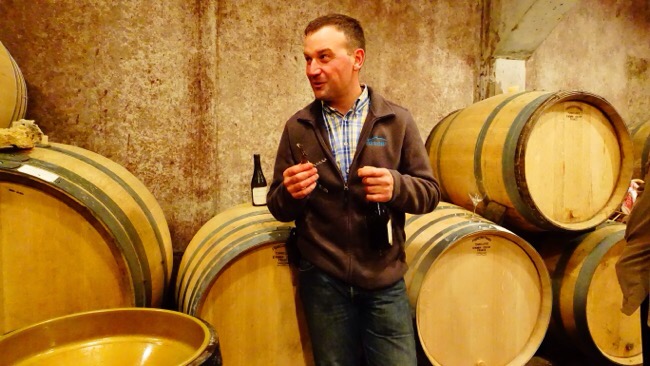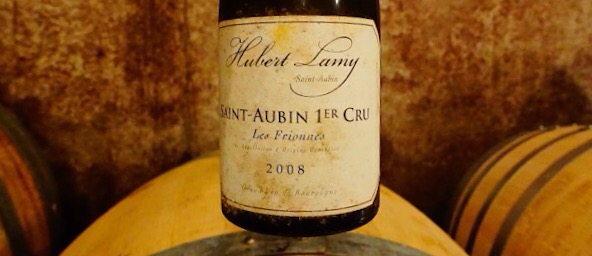It´s getting increasingly difficult and expensive to find high quality corks for our beloved Burgundies.
The share of corked wines (tainted with TCA) seems to increase over the years, and many think the Premox problems somehow are related to the decreasing and variable quality of the corks available.
Quite many producers are therefore looking for alternatives to the traditional cork, and there are now many alternatives on the market – and quite a few producers have implemented these solutions on a selection of wines. A few have however gone all the way and use alternatives to the traditional cork even in the Grand Cru wines … Domaine Ponsot is a noticeable example of this.

Photo: Olivier Lamy of Domaine Hubert Lamy
During my November trip to Burgundy I had the possibility to participate in a small test of different closures at Domaine Huber Lamy. It was very interesting and educational … and I therefore feel compelled to write an article about the experiment and my thoughts about corks an closures.
The Diam closure
One of the most prominent closure solutions is the Diam a series of “artificial” cork made by Diam Closures. The Diam corks are made from milled cork glued together and looks a bit like the well known agglomerated corks. The cork is cleaned for TCA and other problems using a special process. – see the video below and the Diam website for more info.
Diam is becoming quite widely used in Burgundy, and I hear that a lot of producers have made extensive tests with Diam and other closures. Among the well known producers using Diam for a selction of the whites are Bouchard Pere et Fils, William Fevre and Louis Jadot.
Purpose and possibilities
Before we go to the tasting notes I would like to address a few things. The first thing is pretty simple … all people want to avoid corked wines, and these new closures including Diam ensure that the TCA problem is eliminated. So far so good.
The second thing is oxidation, where the different types of enclosures offer a certain level of oxidation of the bottle- the traditional cork is a product of nature, and therefore the oxidation varies from cork to cork. But the new closures like Diam offer a uniform oxidation in all bottles using the same type of enclosure … i.e. all wines should be exposed to the same amount of oxygen through the enclosure and therefore develop less variation over time.
The second element above is addressing the “cork part” of the premox problem … and that some bottles due to a poor corks develop very quickly during cellaring.
I think most would agree that less variation is a good thing … although its important to notice that variation is both good and bad if the average remains the same. So the interesting and controversial part is … how does these new closures perform when compared with the perfect bottle bottled with a natural and traditional cork.
The last element partly addresses the amount of oxidation … the natural and traditional cork has a variable inflow of oxygen, while the “artificial” corks allow a predefined level of oxidation. Diam offer some closures with little flow of oxygen and some that are allows more oxygen to the wine though the closure.
The producer can therefore – in principle – decide how fast the wine should develop after bottling.
Preferences and use
The optimal level of oxidation through the cork is in my view quite difficult to set. Some like the wines young and crisp, while others like me adore mature wines … often cellared for many years.
The question is therefore – does these new closures ensure a natural oxidation like we know from the corks … but without the annoying variation we see with the traditional corks. Or do they seal off more oxygen and therefore conserve the wine longer?
The simple experiment – test of three closures at Domaine Hubert Lamy
Olivier Lamy is a fantastic vigneron … his energy and willingness to experiment is quite unique, and he is very open and interested in sharing his knowledge with the visitors.
So when he offered that we could compare different closures on the 2008 Saint-Aubin Les Frionnes I was very exited.
The experiment was simple semi-blind tasting of three half bottles of Les Frionnes 2008 .. one with traditional cork, one with Diam 5 and one with Diam 10.
We knew it was the 2008 Les Frionnes in all three half bottles, but the enclosures were not revealed until we had evaluated the tasting of the three bottles.
Hubert Lamy Saint-Aubin Les Frionnes 2008 – traditional cork
The first wine offered a lovely complex nose, with quite youthful fruit and some more matured elements – hints of hazelnuts and almonds. On the palate quite open and rich and very balanced – slightly buttery – with the 2008 acidity offering freshness and energy. A lovely matured glass of Saint-Aubin … lovely now, but would keep 5 years more on the half bottle. Personally I would drink it now and over next few years if from half bottle.
Hubert Lamy Saint-Aubin Les Frionnes 2008 – Diam 5
The second wine offered a more youthful expression – more citrus driven bouquet and palate. More focused and with less complexity. To my mind a quite young wine … that I would keep some years more in the cellar … to get it to reach the same level of maturity as the first wine.
Hubert Lamy Saint-Aubin Les Frionnes 2008 – Diam 10
The last wine was even more undeveloped and youthful. The difference between the Diam 5 and the Diam 10 bottle was not huge – but still the Diam 5 seemed at least one year more developed than the Diam 10 bottle – perhaps even more. The expression was that of a young wine – and would be perceived as young when served blind. Again I lacked the complexity of the first wine … and would cellar this for further 3 to 5 years.
Reflections and thoughts about the experiment
I think its pretty easy to be biased in tastings like this, as one is looking for differences and problems in the wines.
I must however say, that I preferred the traditional cork in this test – because the wine was at the maturity level I would expect for a wine like Les Frionnes 2008 served from a half bottle.
The two Diam wines were less developed, but I can’t really say the were better or worse than the wine with traditional cork … but they were indeed less developed and more fresh. I would need to make more experiments to establish an opinion about the quality level … as my opinion would be too biased if based only on this.
The empirical evidence here is pretty meager – perhaps the wine with the natural cork was more developed than the average wine with natural cork, thus making the two Diam wines seem even more youthful. Or perhaps the wine with the cork was just a pristine example offering more complexity
So lets not jump to very strong conclusions here … and try to quantify the differences between the three enclosures in years of development or quality level.
I think its very interesting to follow this development .. and will try to do more of these tests if possible.


 - A true vin d’émotion – a Burgundy of passion
- A true vin d’émotion – a Burgundy of passion - A truly hedonistic wine – lively and enjoyable
- A truly hedonistic wine – lively and enjoyable - A vivacious wine for pure indulgance
- A vivacious wine for pure indulgance - A potential vin d´émotion - frais et léger
- A potential vin d´émotion - frais et léger